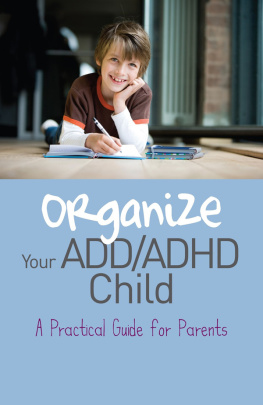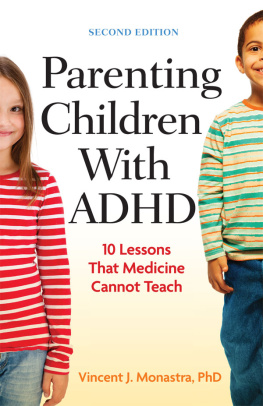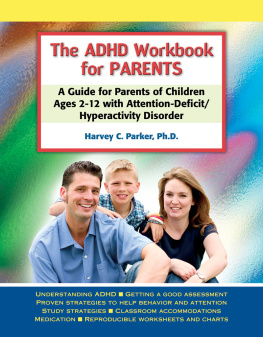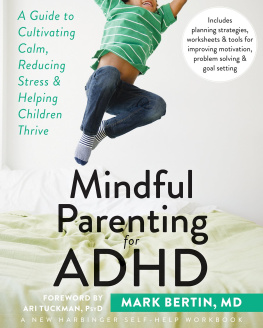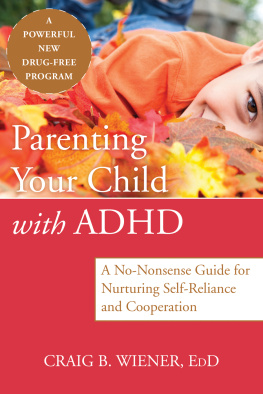of related interest
ADHDLiving without Brakes
Martin L. Kutscher MD
Illustrated by Douglas Puder, MD
ISBN 978 1 84310 873 3 HARDBACK
ISBN 978 1 84905 816 2 PAPERBACK
eISBN 978 1 84642 769 5
The ADHD Handbook
A Guide for Parents and Professionals
Alison Munden and Jon Arcelus
ISBN 978 1 85302 756 7
eISBN 978 0 85700 105 4
Parenting the ADD Child
Cant Do? Wont Do? Practical Strategies for Managing Behaviour Problems in Children with ADD and ADHD
David Pentecost
ISBN 978 1 85302 811 3
eISBN 978 0 85700 143 6
Understanding Motor Skills in Children with Dyspraxia, ADHD, Autism, and Other Learning Disabilities
A Guide to Improving Coordination
Lisa A. Kurtz
Part of the JKP Essentials series
ISBN 978 1 84310 865 8
eISBN 978 1 84642 672 8
Organize
Your ADD/ADHD
Child
A Practical Guide for Parents
CHERYL R. CARTER
Jessica Kingsley Publishers
London and Philadelphia
First published in 2011
by Jessica Kingsley Publishers
73 Collier Street
London N1 9BE, UK
and
400 Market Street, Suite 400
Philadelphia, PA 19106, USA
www.jkp.com
Copyright Cheryl R. Carter 2011
All rights reserved. No part of this publication may be reproduced in any material form (including photocopying or storing it in any medium by electronic means and whether or not transiently or incidentally to some other use of this publication) without the written permission of the copyright owner except in accordance with the provisions of the Copyright, Designs and Patents Act 1988 or under the terms of a licence issued by the Copyright Licensing Agency Ltd, Saffron House, 610 Kirby Street, London EC1N 8TS. Applications for the copyright owners written permission to reproduce any part of this publication should be addressed to the publisher.
Warning: The doing of an unauthorized act in relation to a copyright work may result in both a civil claim for damages and criminal prosecution.
Library of Congress Cataloging in Publication Data
A CIP catalog record for this book is available from the Library of Congress
British Library Cataloguing in Publication Data
A CIP catalogue record for this book is available from the British Library
ISBN 978 1 84905 839 1
eISBN 978 0 85700 343 0
Dedicated to my students
DISCLAIMER
This book is not intended to diagnose, treat or evaluate Attention Deficit Disorder or Attention Deficit Disorder with Hyperactivity (ADD/ADHD). The author and publisher assume an accurate diagnosis has been made clinically or educationally and the reader is acting on that information. See the list of organizations in the useful resources section for information and resources on ADD/ADHD issues. Please be aware that this book will solely address the issues of disorganization and time management in relation to ADD/ADHD itself.
The author recognizes that the term ADHD is the correct medical term and that there are primarily three variations of ADHD: inattentive, hyperactive-impulsive and combined. Most parents refer to ADHD as ADD and therefore this book generally refers to ADD to be representative of all the medical forms of ADHD. See the list of useful resources at the end of the text for information on ADD/ADHD.
Please note that when referring to the child with ADD, he/she and his/her are used interchangeably throughout this book.
Introduction: No More Lost Homework
LETS BEGIN
Missing homework again? You saw him do it and told him to put it in his backpack, so where could it be? This is not the first time. Youve tried everythingthreats, taking away privileges, giving privileges, but nothing seems to work. You have heard that ADD children are difficult to organize but it just cannot go on any longer. You need help. Traditional methods just dont seem to work with your child. Children with ADD generally have difficulty focusing or concentrating on a task. Additionally, these children are also known for being impulsive, highly distractible, indecisive, forgetful and chronically disorganized.
ADD is much more complex than just the symptoms but the scope of this book is to address those typical ADD disorganization symptoms. The term ADD will generally be used but the ideas equally apply to ADHD children. In my previous book Clean Your Room So I Can At Least See the Floor, I introduced the F.I.R.S.T. way to organize children. I have found most children can easily be organized if organization incorporates fun, values them as individuals, guides them with rules, keeps the whole process simple and teaches basic time management principles. Fun, individualism, rules, simplicity and time management are the keys to organizing children. Taking the first letter of each of the five elements (fun, individualism, rules, simplicity and time management) we get the acronym F.I.R.S.T. These elements are all based on an understanding of child development and human nature and can easily be applied to ADD children.
The premise of the F.I.R.S.T. way to organize is that we build on the F.I.R.S.T. model by adding a second layer for ADD children. These children need fun balanced with firmness, individuality with an emphasis on their interests, rules with a regular routine, simplicity coupled with specifics, and time management with an understanding of transitions. I will discuss each of these steps in detail as we progress through the book.
The F.I.R.S.T. method works well when we consciously apply it to our organizing efforts because it addresses core issues of child development. Nearly all children want to have fun, be recognized as an individual, require the safety of structure and rules, need to be communicated to on their level in a simple way so they can easily understand, and, finally, they need to develop time consciousness.
Before we can delve into the execution of the F.I.R.S.T. approach, lets lay a foundation on how children are trained. Training with children occurs in five sequential steps. Some ADD children may need to be prodded through the steps. For instance, ADD children may enjoy your company so much in step one that they are reluctant to master a skill and then move to the next step. You may have to insist the child move along even if she is resistant initially.
The following steps are generally the way children are trained to do household chores.
STEP ONEDEMONSTRATE
This is the basic step. Simply allow your child to observe you several times doing a task. Toddlers and preschoolers do this naturally (notice how their play imitates what they see in real life). For instance, if you want your child to make his bed, let him observe you making your bed several times. Talk to him about the steps involved in making his bed as he watches you make the bed. This step has to be deliberate. You cannot just assume your child knows how to do a task if he has not intentionally observed you performing the task.
To maintain your childs attention during this step, have him actively imitate you. For example, he can pretend he is smoothing the wrinkles by panning his hands in the air pantomiming the motion while you are actually smoothing the wrinkles on the bed. It is essential that children are doing something other than just watching you. Many ADD children need to engage in motion to really concentrate on instruction. If you force an ADD child to be completely still he may be focused on staying still and miss out on everything you are saying to him. Older children may find it silly to pantomime but they can still illustrate with their hands or speak aloud each step necessary to complete the task successfully.
Next page
